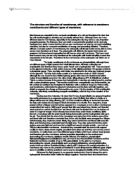The structure and function of membranes, with reference to membrane constituents and different types of membrane.
The structure and function of membranes, with reference to membrane constituents and different types of membrane.
Membranes are essential for the compartmentalisation of a cell and therefore it is clear that the cell would struggle to develop any complexity without them. Although there are many different uses for membranes, especially in the eukaryotic cell, they serve a very important energetic purpose. For instance, they can retain a concentration gradient of, for example, Hydrogen ion, which means that the cell can use membranes not only for compartmentalising reactions, but also for compartmentalisation of energy and preventing diffusion. Therefore, without a complex system of membranes, the eukaryotic cell simply would not be able to carry out as many functions as it does. The prokaryotic cell differs in the sense that it does not possess membrane-bound organelles but still has an outer cell membrane. This has meant that it cannot carry out as many functions as the eukaryotic cells but its simplicity means that reproduction is far simpler. Therefore it is the membranes of the eukaryotic cell which are of more interest
The basic constituents of all membranes are phospholipids, although there are different types of lipid present that I shall discuss later. All these molecules are amphipathic and therefore they have a polar ‘head’ and a hydrophobic ‘tail’. They are based on the glycerol molecule, a triol, which uses one of its slightly polarised -OH groups to bind to a phosphate group. Then, two fatty acid chains are attached to the other two hydroxyl groups on the glycerol. The fatty acid chains consist of a hydrocarbon chain of 16-20 carbons although the one bound to the middle hydroxyl group often has a cis double bond which makes it bend slightly away from the other chain. [diag.alberts,p.277, 6-2(b)without choline] This is a curious process in the sense that hydrophobic molecules are being bound to another with a polar phosphate group. This reaction would seem energetically very unfavourable, yet it is carried out easily in the Endoplasmic Reticulum with a series of enzymes. Presumably, acyl transferase, which joins the glycerol 3-phosphate and the fatty acid tails together, can shield or separate the charge so that reaction can occur. It is the creation of this amphipathic molecule, effectively contradicting energetic sensibilities, which is key to the creation of the membrane.
Having seen the molecule, it is clear that if many phospholipids are grouped together into stable structures in an aqueous environment, then it is likely that either a micelle or a bilayer will be formed. [diag.alberts,p.277, 6-3]The micelle is unlikely to be formed because the fatty acid chains are too large to fit into the interior of a micelle. For a long time, it was presumed that a bilayer was formed (as opposed to a monolayer or some other membranous construction) but only in 1925 was it ‘proved’ that this was indeed true. Gorter and Grendel used acetone to extract the lipid from red blood cells and the floated them on the surface of water in Langmuir trough. It had already been shown that, under these conditions, lipids formed a monolayer with the polar heads facing downwards and the hydrophobic tails up in the air. They found that the area of the monolayer was twice that of the surface area of the red blood cells and therefore concluded that, in the cell, the lipids were arranged in a bilayer. Unfortunately, they made two errors: firstly, they assumed that the red blood cells were flat discs and therefore they underestimated the lipid area. They also assumed that the entire surface area was lipid and we know that a significant area is actually protein – as much as 76% in mitochondrial membranes – therefore they overestimated the area in this respect. Luckily for them, these errors roughly cancelled each other out and they came to the correct conclusion. In reality there are many different types of lipid, which have various head groups and therefore give the membrane various properties depending on the environment surrounding the membrane, fluidity is usually affected. For instance, phospholipid diphosphatidylglycerol (cardiolipin) is very common in the mitochondrial membrane and the thylakoid membrane consists of up to 70% galactolipids. In the plasma membrane surrounding the cytosol, phospholipids such as phosphatidylserine, phosphatidylcholine predominate as well as cholesterol.[diag.Lodisch.p597] However the overall properties of a membrane rely more on the proteins embedded in it and it likely that the different types of lipid serve to stabilise or aid the proteins in some way by changing the fluidity of the membrane.







